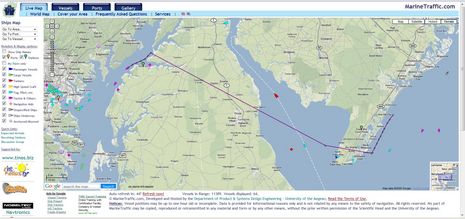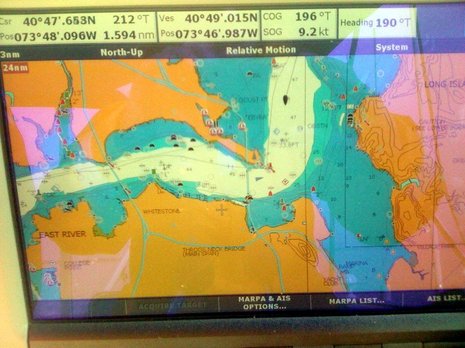M/V Brilliant, loving AIS
I am a wee bit jealous. That’s my brother-in-law Richard Itkin driving his Grand Banks 42 Brilliant down Chesapeake Bay this morning, having left New York Harbor yesterday morning (and Barrington, RI, on Tuesday). As a guy who drove submarines and sub tenders for the U.S. Navy, Rich has a well developed appreciation for collision avoidance, and he’s been tickled with the ACR Nauticast B AIS transponder he installed a few weeks ago. But before I pass on his reports, please click on the screen above and note something I just realized regarding MarineTraffic.com.
In fact, deciphering that screen might help many to understand what’s happening on any live AIS Web site. Though it may lead to some bogus track lines, the way Marine Traffic connects whatever its network of listening stations has collected in the last 24 hours certainly shows how scattered the stations are, and how much less coverage 2 watt Class B AIS signals get compared to 12 watt Class A. Plus it turns out that if you select that green “Stations” icon upper left (normally off), you can not only see where (at least some of) the listening towers actually are, but you can also click on them for info about the hardware and software being used, number and distance of vessels recently seen, etc. It’s all very neatly done, but obviously we need more volunteer listeners if we want to consistently track our Class B buddies up and down the coasts. The good folks at Marine Traffic have all the dope on how to volunteer.
Of course someone like Rich who’s actually boating the coast doesn’t really care about shore stations (though maybe he was “naval gazing” on his iPhone, as the feeds above are on Ship Finder). What he was excited about when he called was how useful his transponder had been when things got a little complicated as several vessels converged on the C&D Canal’s east entrance in the dark this morning. He’d been able to easily speak via VHF with the bridge personnel on two tugs and learned that both could see Brilliant fine. On yesterday’s call he told me how great it had been to see the ship below emerging from the East River well before he got a visual, especially as that didn’t happen until they were very close, and the big guy was hogging the channel. Now that Rich is in the sunny south, maybe he’ll learn to take better pictures (or Raymarine C120W screen shots) for future Panbo use (or his own blog). Just kidding!















Ben, the MarineTraffic.com recieving station information is at least occasionally incomplete. For example, “Station 51”, shown in Oakland, California, is actually an aggregated feed from about four San Francisco-area stations all within perhaps a 100 mile radius (I’m one of them). We combine and share our data, and send the aggregated AIS data to MarineTraffic.com.
So, there are more stations, and more widely distributed than indicated by MarineTraffic.com. However, the coverage is still very spotty.
It is possible to embed the MarineTraffic.com chart in your own website. I’ve got one, primed to zoom in on VALIS when her transponder is turned on, on the VALIS website (http://www.sailvalis.com/AisTracking.htm)
Another very interesting AIS sharing website is http://www.AisHub.net — but you need to send them data before you get to receive their worldwide data. One nice thing about AisHub is that they have lots of Class-B traffic (since Class-B has been in use much longer in Europe, where much of their AIS data is coming from), and they also have live AIS traffic from SAR and Aids to Navigation (AtoN). If you are testing AIS gear, having the data from a wide variety of station types is extremely handy.
That’s not only transmit power, antenna height is also very important. For merchant vessels its much higher than yachts, so radiohorizon is much far.
Brilliant probably passed within about 1000 yards of where I am sitting right now. Too bad I was not logging AIS data at the time. Very few Class B transmitters are seen in this area, based on several 24 hour weekend periods for which I collected data.
Speaking of the Web and AIS, that stationary vessel near the boat ahead of Brilliant is “betterpets.com” with a Class A transmitter. It
is a few miles North of me and I went to the betterpets.com Web site because I see it on my chartplotter all the time even though I have
never seen the boat itself. I suppose that the extra range of Class A is well worth the cost for this guy!
Jon
Internet AIS sites are common now, but can we say for sure that they are legal? What value does it add for the boat on the water? I can see that it would inhibit many from installing AIS in their boats, which defeats the purpose.
Norse, amateur, commercial, and government AIS Web tracking is going on all over the world; it is obviously not illegal. And I suspect that there are many more boaters who like the idea of being tracked on the Web than there are those who don’t. If the fear is being targeted, that doesn’t make a lot of sense. A bad guy who can set up a good receiver for a few hundred dollars doesn’t need Web tracking.
JonM, That other ‘yacht’ icon just off “betterpets.com” in the screen shot is also a Class B, a sailboat called “Daydreamer”. You can look up her yesterday’s track via Vessels/ Show All at the Marine Traffic site.
I wonder if the next generation of AIS class “A” transponders will be priced low enough to attract recreational boaters. There’s a big difference between 2 watts and 12 watts. If one is serious about the value of this technology and also does some serious coastal sailing they may be willing to spend more for more coverage. Is a $1200 to $1500 class “A” in the future?
SRT has suggested that there may be Class A transponders available at “well below $2,000” retail in the next year or so:
https://panbo.com/archives/2009/08/srt_blowing_the_ais_doors_off.html
How far off do you think you need to be seen? On the open sea large vessels see my class B at least 10 miles away, which is plenty to negotiate a meeting.